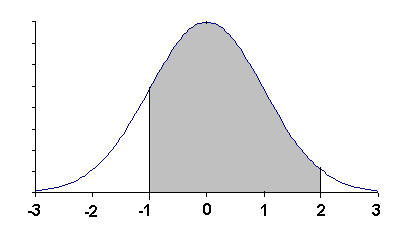To Notes
The Normal Distribution
Introduction
- A univariate dataset that has an approximately bell-shaped
histogram is said to have a normal distribution.
- Here some examples of datasets that have approximately normal distributions:
Heights of living things, weights of living things, lengths of inert
appendages (hair, claws, nails, teeth) of biological specimens in
the direction of growth, blood pressure of adult humans of fixed gender,
velocities of molecules in an ideal gas, measurement errors, IQ scores,
SAT scores.
In finance, changes in the logarithm of exchange rates, price indices,
and stock market indices are assumed normal in the
Black-Scholes Model. The logarithm is used in the Black-Scholes
model because these values behave like compound interest and so are
multiplicative.
- Abraham DeMoivre was the first to write down the equation for
the a normal histogram with center μ = 0 and spread
σ = 1:
p(x) = (1 / √2π)
exp(-0.5x2) =
0.39894 * 2.71828 ** (-0.5x2)
Recall that π = 3.14159 and e = 2.71828.
- Use SPSS to plot the normal curve for the
z values from -4 to 4 by 0.1
- If x and SD really a parsimonious description
of a histogram, then given x and SD, we should be
able to reconstruct the histogram; that is, we should be able to predict
the proportion of observations in any bin of the form
(-∞, a], (a, ∞], or [a, b].
- We start with the simplest case of a normal histogram with center 0
and spread 1.
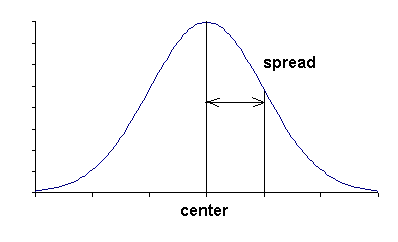
- Our tool for finding areas under the normal curve is the
standard normal table.
- Example 1: What proportion of the observations are in
this bin: (-∞, -1.00]?
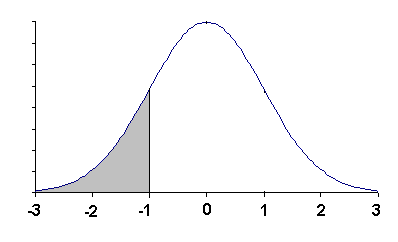
Solution: The value -1.00 on the x-axis of the normal curve is called
a z-value. Use the first table in the
normal table for negative numbers. Look in the -1.0 row and the
.00 column to find .1587. The answer is: 0.1587.
- Example 2: What proportion of the observations are in
this bin: (-∞, 2.00]?
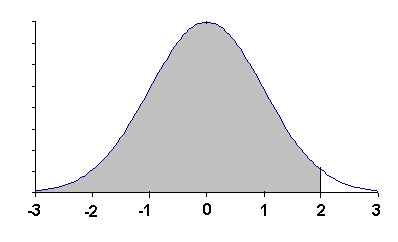
Solution: Look the z-value 2.00 up in the second table for positive numbers,
also in
the normal table. Look in the 2.0 row and
the 0.00 column to find .9772. The answer is 0.9772.
- Example 3: What proportion of the observations are in
this bin: (-3.00, 3.00]?
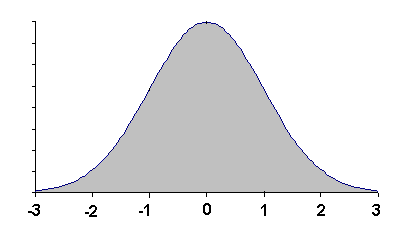
Solution: (-3.00, 2.00] can be written as the set-theoretic difference
(-∞, 3.00] - (-∞, -3.00]. Look up these bins in
the normal table: (-∞, 3.00] has the proportion 0.9987
and (-∞, -3.00] has the proportion 0.0013. Therefore
the proportion of observations in (-3.00, 2.00] =
(-∞, 3.00] - (-∞, -3.00] is
0.9987 - 0.0013 = 0.9974.
- Note: is does not matter whether we ask for the proportion of observations
in (-3.00, 2.00], (-3.00, 2.00), [-3.00, 2.00), or [-3.00, 2.00]. They
contain the same proportion of observations because the normal curve is
an idealized continuous histogram where the the proportion of observations
at a single point is always zero.
- Example 4: What proportion of the observations are in
this bin: (1.5, 2.5]?
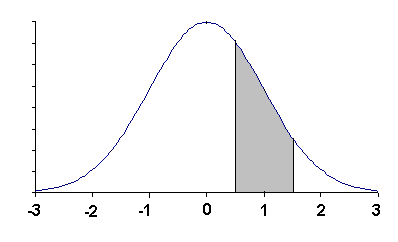
Solution: (1.50, 2.50] = (-∞, 2.50] - (-∞, 1.50]. The
the normal table gives the proportion of observations as 0.9938 - 0.9332 = 0.0606.
- In the case where the normal histogram is not standard, any intervals
must be first converted to standard units by subtracting off the mean
and then dividing by the standard deviation.
- The values converted to standard units are called z-scores.
- Example 5: If the mean is 50 and the standard deviation is
10, what proportion of the observations are between 40 and 70?
Solution:
Convert 40 and 70 to z-scores:
z = (x - μ) / σ = (40 - 50) / 10 = -1
and
z = (x - μ) / σ = (70 - 50) / 10 = 2
Then the proportion of observations in the bin (-1, 2] =
(-∞, 2] - (-∞, -1] is 0.9772 - 0.1587 = 0.8185.
